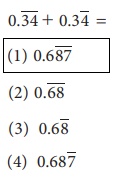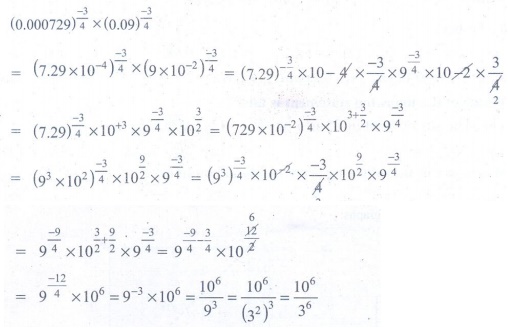Numerical Problems with Answers, Solution | Real Numbers | Maths - Exercise 2.9: One Mark Multiple Choose the correct Answers | 9th Maths : UNIT 2 : Real Numbers
Chapter: 9th Maths : UNIT 2 : Real Numbers
Exercise 2.9: One Mark Multiple Choose the correct Answers
Real Numbers
Exercise 2.9
1.
If n is a natural number then √n is
(1)
always a natural number.
(2)
always an irrational number.
(3)
always a rational number
(4) may be rational or irrational
[ Answer: (4) may be rational or irrational ]
2.
Which of the following is not true?.
(1)
Every rational number is a real number.
(2)
Every integer is a rational number.
(3) Every real number is an irrational
number.
(4)
Every natural number is a whole number.
Solution: Real numbers contain
rationals and irrationals.
[ Answer: (3) Every real number is an irrational number]
3.
Which one of the following, regarding sum of two irrational numbers, is true?
(1)
always an irrational number.
(2) may be a rational or irrational number.
(3)
always a rational number.
(4)
always an integer.
[ Answer: (2) may be a rational or irrational number]
4.
Which one of the following has a terminating decimal expansion?.
(1) 5/64
(2)
8/9
(3)
14/15
(4)
1/12
Solution: 5/64 = 5/26
[ Answer: (1) 5/64 ]
5.
Which one of the following is an irrational number
(1)
√25
(2)
√(9 /4)
(3)
7/11
(4) π
Solution: π represents a irrational
number
[ Answer: (4) π]
6.
An irrational number between 2 and 2.5 is
(1)
√11
(2) √5
(3)
√2.5
(4)
√8
Solution: 22 = 4 and 2.52
= 6.25
[ Answer: (2) √5]
7.
The smallest rational number by which 1/3 should be multiplied so that its decimal
expansion terminates with one place of decimal is
(1)
1/10
(2) 3/10
(3)
3
(4)
30
Solution: 3/10 is the small number.
[ Answer: (2) 3/10]
8.
If 1/7 =  then the value of 5/7 is
then the value of 5/7 is

Solution:

[ Answer: (2) ]
9.
Find the odd one out of the following.
(1)
√32 × √2
(2)
√27 / √3
(3)
√72 × √8
(4) √54 / √18
Solution:
√72 × √8 = √[9×8] × √8 = 3×8 = 24;
√32 × √2 = √[16×2] × √2 = 4×2=8;
√27 ÷ √3 = √[9×3] × √3 = 3×3=9;
√54 ÷ √18 = √[3×18] × √18 = √3×18=18√3;
[Answer: (4) √54 ÷ √18 ]
10.

Solution: 0.343434… + 0.344444…
[ Answer: (1) ]
11.
Which of the following statement is false?
(1)
The square root of 25 is 5 or −5
(2)
– √25 = −5
(3) √25 = 5
(4) √25 = ± 5
[ Answer: (4) √25 = ± 5]
12.
Which one of the following is not a rational number?
(1)
√[8/18]
(2)
7/3
(3)
√0. 01
(4) √13
Solution:
√(8/18) = √(4/9) = 2/3 is a rational number;
7/3 is a rational number
√0.01 - √(1/100)=1/10 is a rational number
√13 is not a rational number
[ Answer: (4) √13]
13.
√27+ √12 =
(1)
√39
(2)
5√6
(3) 5√3
(4)
3√5
Solution: √27 + √12 = √[9×3]
+ √[4×3] = 3√3 + 2√3 = 5√3
[ Answer: (3) 5√3]
14.
If √80 = k√5, then k =
(1)
2
(2) 4
(3)
8
(4)
16
Solution: √80 = √[16×5] =
4√5 = k√5 ⇒ k=4
[ Answer: (2) 4]
15.
4√7×2√3=
(1)
6√10
(2) 8√21
(3)
8√10
(4)
6√21
Solution: 4√7 × 2√3 = 8 ×
√[7×3] = 8√21
[ Answer: (2) 8√21]
16.
When written with a rational denominator, the expression 2√3 / 3√2 can be simplified
as
(1)
√2 / 3
(2)
√3 / 2
(3) √6 / 3
(4)
2 / 3
Solution: 2√3 / 3√2 = 2√3
× √2 / 3√2 × √2 = 2√6 / 3×2 = 2√6 / 6 = √6/3
[ Answer: (3) √6 / 3]
17.
When (2√5 − √2)2 is simplified, we get
(1) 4√5+2√2
(2) 22-4√10
(3)
8-4√10
(4)
2√10-2
Solution:
(2√5 - √2)2
= (2√5)2 – 2 × 2√5 × √2 +√22
=
4×5 – 4√10
+ 2 = 22 - 4√10
[ Answer: (2) 22-4√10 ]
18.
( 0. 000729 )-3/4 × (0.09 )-3/4 = ______
(1)
103 / 33
(2)
105 / 35
(3)
102 / 32
(4) 106 / 36
Solution:

[ Answer: (4) 106 / 36 ]
19.
If √9x = 3√92
, then x = ______
(1)
2 / 3
(2) 4 / 3
(3)
1 / 3
(4)
5/ 3
Solution: (9x)1/2 = (92)1/3
⇒ 9x/2 = 92/3
⇒ x/3 = 2/3
3x = 4
x= 4/3
[ Answer: (2) 4 / 3 ]
20.
The length and breadth of a rectangular plot are 5×105 and 4×104
metres respectively. Its area is ______.
(1)
9×101 m2
(2)
9×109 m2
(3) 2×1010 m2
(4)
20×1020 m2
Solution:
l =5 × 105 metres; b
= 4 × 104 metres
Area = l × b
= 5 × l05 ×
4 × l04 = 20 x 105+4 = 20 × 109 = 2.0 x 101
× 109
= 2 × 1010 m2
[ Answer: (3) 2×1010 m2
]
Related Topics